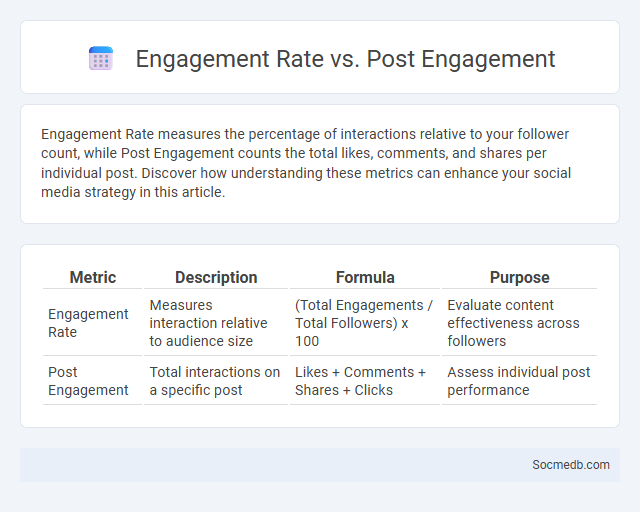
Photo illustration: Engagement Rate vs Post Engagement
Engagement Rate measures the percentage of interactions relative to your follower count, while Post Engagement counts the total likes, comments, and shares per individual post. Discover how understanding these metrics can enhance your social media strategy in this article.
Table of Comparison
| Metric | Description | Formula | Purpose |
|---|---|---|---|
| Engagement Rate | Measures interaction relative to audience size | (Total Engagements / Total Followers) x 100 | Evaluate content effectiveness across followers |
| Post Engagement | Total interactions on a specific post | Likes + Comments + Shares + Clicks | Assess individual post performance |
Understanding Engagement Rate: Definition and Importance
Engagement rate measures the level of interaction your audience has with your social media content, calculated by dividing total engagements (likes, comments, shares) by the number of followers or impressions. This metric is crucial for assessing the effectiveness of your social media strategy and understanding how well your content resonates with your target audience. Knowing your engagement rate helps optimize content creation, improve audience targeting, and drive higher conversion rates.
What is Post Engagement? Breaking Down the Metrics
Post engagement on social media refers to the various interactions users have with content, including likes, comments, shares, and clicks. Key metrics breaking down post engagement include engagement rate, which measures the percentage of audience interactions relative to total impressions or reach, and specific actions like reaction types and time spent on posts. Analyzing these metrics helps brands understand content effectiveness, audience preferences, and optimize strategies for higher visibility and interaction.
Engagement Rate vs Post Engagement: Key Differences
Engagement Rate measures the percentage of your audience that interacts with your social media content, providing a clear insight into how well your posts resonate with followers relative to your total reach. Post Engagement refers to the total number of interactions, such as likes, comments, shares, and clicks, received on a specific post, offering raw data on content performance. Understanding the distinction between these metrics helps you optimize your strategy by balancing quantity with quality of interactions to boost Your overall social media impact.
Why Engagement Rate Matters in Social Media Marketing
Engagement rate measures the level of interaction between content and its audience, providing critical insights into how well a brand resonates with followers on platforms like Instagram, Facebook, and Twitter. High engagement rates indicate effective content strategies that drive likes, comments, shares, and clicks, ultimately boosting brand visibility and loyalty. Marketers prioritize engagement metrics to optimize campaigns, enhance customer relationships, and increase conversions in competitive social media environments.
How to Calculate Engagement Rate and Post Engagement
Calculating engagement rate involves dividing the total interactions (likes, comments, shares) by the total number of followers, then multiplying by 100 to get a percentage. Post engagement specifically measures the sum of likes, comments, shares, and clicks on an individual post, reflecting user interaction quality. Tracking these metrics helps optimize social media strategies for better audience connection and growth.
Factors Influencing Engagement Rate and Post Engagement
Engagement rate on social media is driven by content relevance, audience demographics, posting time, and platform algorithm preferences. High-quality visuals, compelling captions, and interactive elements like polls and questions boost post engagement significantly. Understanding user behavior and leveraging data analytics tools further optimize strategies to increase likes, comments, shares, and overall interaction.
Interpreting Engagement Metrics for Actionable Insights
Interpreting engagement metrics such as likes, comments, shares, and click-through rates provides valuable insights into your audience's preferences and behavior on social media platforms. By analyzing these data points, you can identify which types of content resonate most, optimize posting times, and tailor your marketing strategies for higher impact. Your ability to leverage engagement analytics leads to more informed decisions that drive meaningful interactions and overall growth.
Common Mistakes When Analyzing Engagement Data
Analyzing engagement data often leads to common mistakes such as overemphasizing likes and shares while ignoring comments and sentiment, which provide deeper insight into audience behavior. You must avoid relying solely on vanity metrics and instead focus on meaningful interactions that align with your social media goals. Misinterpreting data without considering the context of post timing, content type, and audience demographics can result in flawed strategies and missed opportunities for growth.
Boosting Engagement: Proven Strategies for Success
Boosting engagement on social media platforms requires leveraging interactive content such as polls, quizzes, and live videos that encourage audience participation. Utilizing data-driven insights from analytics tools helps identify peak activity times and preferred content types, optimizing post timing and relevance. Collaborating with influencers and fostering genuine community interactions enhances visibility and builds trust, driving sustained user engagement.
Choosing the Right Metric: Engagement Rate or Post Engagement?
Choosing the right metric between engagement rate and post engagement depends on your social media objectives and audience size. Engagement rate provides a normalized measure of interaction relative to follower count, offering insight into content effectiveness and audience loyalty. Post engagement, encompassing likes, comments, shares, and saves, delivers absolute interaction numbers useful for tracking popularity and direct impact of individual posts.
 socmedb.com
socmedb.com